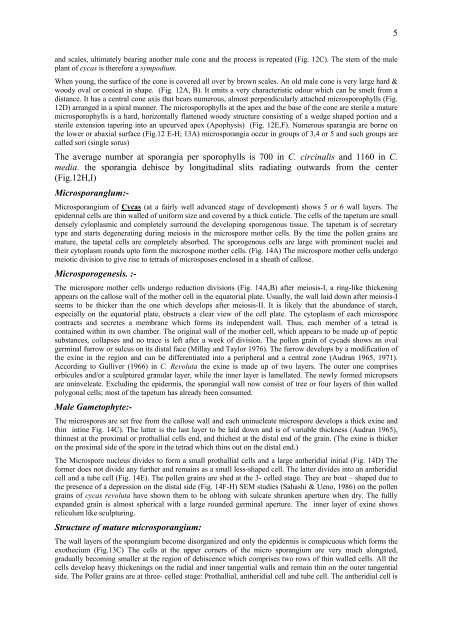Diversity of seed plants and their systematics
Diversity of seed plants and their systematics
Diversity of seed plants and their systematics
Create successful ePaper yourself
Turn your PDF publications into a flip-book with our unique Google optimized e-Paper software.
<strong>and</strong> scales, ultimately bearing another male cone <strong>and</strong> the process is repeated (Fig. 12C). The stem <strong>of</strong> the male<br />
plant <strong>of</strong> cycas is therefore a sympodium.<br />
When young, the surface <strong>of</strong> the cone is covered all over by brown scales. An old male cone is very large hard &<br />
woody oval or conical in shape. (Fig. 12A, B). It emits a very characteristic odour which can be smelt from a<br />
distance. It has a central cone axis that bears numerous, almost perpendicularly attached microsporophylls (Fig.<br />
12D) arranged in a spiral manner. The microsporophylls at the apex <strong>and</strong> the base <strong>of</strong> the cone are sterile a mature<br />
microsporophylls is a hard, horizontally flattened woody structure consisting <strong>of</strong> a wedge shaped portion <strong>and</strong> a<br />
sterile extension tapering into an upcurved apex (Apophysis) (Fig. 12E,F). Numerous sparangia are borne on<br />
the lower or abaxial surface (Fig.12 E-H; 13A) microsporangia occur in groups <strong>of</strong> 3,4 or 5 <strong>and</strong> such groups are<br />
called sori (single sorus)<br />
The average number at sporangia per sporophylls is 700 in C. circinalis <strong>and</strong> 1160 in C.<br />
media. the sporangia dehisce by longitudinal slits radiating outwards from the center<br />
(Fig.12H,I)<br />
Microsporanglum:-<br />
Microsporangium <strong>of</strong> Cycas (at a fairly well advanced stage <strong>of</strong> development) shows 5 or 6 wall layers. The<br />
epidermal cells are thin walled <strong>of</strong> uniform size <strong>and</strong> covered by a thick cuticle. The cells <strong>of</strong> the tapetum are small<br />
densely cyloplasmic <strong>and</strong> completely surround the developing sporogenous tissue. The tapetum is <strong>of</strong> secretary<br />
type <strong>and</strong> starts degenerating during meiosis in the microspore mother cells. By the time the pollen grains are<br />
mature, the tapetal cells are completely absorbed. The sporogenous cells are large with prominent nuclei <strong>and</strong><br />
<strong>their</strong> cytoplasm rounds upto form the microspone mother cells. (Fig. 14A) The microspore mother cells undergo<br />
meiotic division to give rise to tetrads <strong>of</strong> microsposes enclosed in a sheath <strong>of</strong> callose.<br />
Microsporogenesis. :-<br />
The microspore mother cells undergo reduction divisions (Fig. 14A,B) after meiosis-I, a ring-like thickening<br />
appears on the callose wall <strong>of</strong> the mother cell in the equatorial plate. Usually, the wall laid down after meiosis-I<br />
seems to be thicker than the one which develops after meiosis-II. It is likely that the abundance <strong>of</strong> starch,<br />
especially on the equatorial plate, obstructs a clear view <strong>of</strong> the cell plate. The cytoplasm <strong>of</strong> each microspore<br />
contracts <strong>and</strong> secretes a membrane which forms its independent wall. Thus, each member <strong>of</strong> a tetrad is<br />
contained within its own chamber. The original wall <strong>of</strong> the mother cell, which appears to be made up <strong>of</strong> peptic<br />
substances, collapses <strong>and</strong> no trace is left after a week <strong>of</strong> division. The pollen grain <strong>of</strong> cycads shows an oval<br />
germinal furrow or sulcus on its distal face (Millay <strong>and</strong> Taylor 1976). The furrow develops by a modification <strong>of</strong><br />
the exine in the region <strong>and</strong> can be differentiated into a peripheral <strong>and</strong> a central zone (Audran 1965, 1971).<br />
According to Gulliver (1966) in C. Revoluta the exine is made up <strong>of</strong> two layers. The outer one comprises<br />
orbicules <strong>and</strong>/or a sculptured granular layer, while the inner layer is lamellated. The newly formed micropsers<br />
are uninveleate. Excluding the epidermis, the sporangial wall now consist <strong>of</strong> tree or four layers <strong>of</strong> thin walled<br />
polygonal cells; most <strong>of</strong> the tapetum has already been consumed.<br />
Male Gametophyte:-<br />
The microspores are set free from the callose wall <strong>and</strong> each uninucleate microspore develops a thick exine <strong>and</strong><br />
thin intine Fig. 14C). The latter is the last layer to be laid down <strong>and</strong> is <strong>of</strong> variable thickness (Audran 1965),<br />
thinnest at the proximal or prothallial cells end, <strong>and</strong> thichest at the distal end <strong>of</strong> the grain. (The exine is thicker<br />
on the proximal side <strong>of</strong> the spore in the tetrad which thins out on the distal end.)<br />
The Microspore nucleus divides to form a small prothallial cells <strong>and</strong> a large antheridial initial (Fig. 14D) The<br />
former does not divide any further <strong>and</strong> remains as a small less-shaped cell. The latter divides into an antheridial<br />
cell <strong>and</strong> a tube cell (Fig. 14E). The pollen grains are shed at the 3- celled stage. They are boat – shaped due to<br />
the presence <strong>of</strong> a depression on the distal side (Fig. 14F-H) SEM studies (Sahashi & Ueno, 1986) on the pollen<br />
grains <strong>of</strong> cycas revoluta have shown them to be oblong with sulcate shrunken aperture when dry. The fullly<br />
exp<strong>and</strong>ed grain is almost spherical with a large rounded germinal aperture. The inner layer <strong>of</strong> exine shows<br />
reliculum like sculpturing.<br />
Structure <strong>of</strong> mature microsporangium:<br />
The wall layers <strong>of</strong> the sporangium become disorganized <strong>and</strong> only the epidermis is conspicuous which forms the<br />
exothecium (Fig.13C) The cells at the upper corners <strong>of</strong> the micro sporangium are very much alongated,<br />
gradually becoming smaller at the region <strong>of</strong> dehiscence which comprises two rows <strong>of</strong> thin walled cells. All the<br />
cells develop heavy thickenings on the radial <strong>and</strong> inner tangential walls <strong>and</strong> remain thin on the outer tangential<br />
side. The Poller grains are at three- celled stage: Prothallial, antheridial cell <strong>and</strong> tube cell. The antheridial cell is<br />
5

















